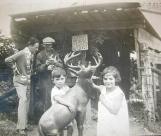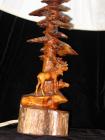1
Charles August Vollrath:Text and Photography
by Brenda Lee-Whiting
The ability to carve wood is enjoyed by so many descendants of German immigrants who came to Renfrew County in the 19th century that it would be ividious to list their names. But even those who are skilled enough to earn prizes in international competitions regard it as a hobby and not as a sole source of income. Those whose parents or grandparents struggeld with the tasks of creating a farm from rough and infertile land tend to create models that show the tasks of pioneer living or scenes from lumbering camps.
There was one German immigrant, though, whose skill in woodcarving earned him a living in the difficult years of the 1930s; his carvings have probably travelled to many parts of Canada.
Born in Kleinhersberg (which his descendants believe to have been in Schleswig-Holstein), Charles August Vollrath immigrated from Germany to Canada in 1892, at the age of 22, with his first wife, Alvina Woockman and a young child. For a few years the family lived in Ottawa, where Vollrath worked in the brickyards, but the couple moved to Chalk River in 1900, apparently on foot, for they brought with them a cow.
Following the death of his first wife, Charles Vollrath married Margarethe Hollmer, in 1902. After travels that took them to the United States, the couple returned to the Chalk River area, settled on a farm in Buchanan Township in 1905, and began to raise a family of four sons and four daughters. Farming offered a poor livelihood, and soon after the National Forest Experimental Station was started in 1918, on part of the Petawawa Military Reserve, nearby, Charles Vollrath began to work there. His work in the bush, and his experience in farming on wild wooded land were presumably where this German immigrant gained his knowledge of wild animals of eastern Ontario which he carved out of wood - and for which he became famous. Even before he moved into a house in the village of Chalk River, in 1921, and had abandoned farming for forestry, his carved animals were objects of admiration.
At first it was just a hobby and he gave away the carvings to friends and neighbours. One of the men that lived near to him in Chalk River was named Christink, one of three brothers that had come out to Canada in 1880. Another brother, Irving Christink, and his family lived in Alice Township, close to Pembroke. When a professional photographer visited the farm of Irving Christink in 1912, to take a formal picture of the family members standing in front of their squared log farmhouse, somebody with a sense of humour placed a carving of a moose in the line-up of uncles and aunts and cousins and grandparents. This carving had been made by Charles Vollrath and it is in the possession of a descendant of the Christink family, one who removed it from the top of the family's organ before the log building was demolished in the 1950s.
No one seems to be sure just when Charles Vollrath made the leap from a hobby to a full-time career as a woodcarver. His surviving children agree that he was not taught by anyone; his was a natural talent which they regard as a "gift." On the passport he acquired in April, 1931 as a British subject by naturalization and of German origin, he listed his profession as a woodcarver. After his appearance at the Chicago World Fair of 1933, he never needed to look for employment again. He had been exhibiting at the annual "EX" in Toronto, and throughout the years of the Depression he earned a living with his skilful fingers
His tools were a hatchet, a saw, a chisel and a penknife. His favorite woods were basswood which was plentiful near Chalk River, red cedar which he sometimes obtained from a man at Cobden and red cherry which was found in the Round Lake area - all in Renfrew County. He seldom used pine, but in the last year of his life, at the age of 82, he carved a moose more than five feet tall from a single pine log about 30 inches in diameter. It was a present for the oldest child of his second marriage, Louisa. Most of his carvings were small and some were miniatures so delicate that they could be used as ear-rings or pendants.
The animals that he was most fond of reproducing in wood included moose, deer, beaver, fox, squirrel, bear and chipmunk, and the range of positions or poses seems endless. One of his daughters, Freda, has perhaps a hundred of her father's carvings in her possession, but there must be thousands more scattered across the continent of North America. On some pieces the woodcarver incised his name and the year at the base. Some carvings are unsigned.
At an occasion in Toronto, September 30, 1939, when the Ontario Motor League honoured Dai H. Lewis "in commemoration of his 35 years of service to the cause of motor touring and International Amity," a carving by Charles Vollrath was presented to Mr. Lewis as his retirement gift. The program for that event contained an illustration of a moose carved from basswood, and the organizers described the background and identity of the man who made the carving. "The popular opinion that he is French-Canadian is fallacious, as he is of German descent," was one of the comments. The program also carried an explanation of the location of Chalk River, on the Trans-Canada Highway, north of Ottawa, for it was several years before this village would become well-known as the site of the nuclear laboratories of Atomic Energy of Canada Limited.
It was appropriate that a carving by Charles Vollrath should have been chosen for this occasion by the Ontario Motor League, for it was the popularity of motoring - and the traffic of motorist through Chalk River - that produced for him a constant stream of customers. Chalk River had three gasoline stations in the 1930s: during the summer months Charles Vollrath set up a stand on the highway, near to the gas pumps, where many travellers would see his work and could watch him produce it. Most of his carvings of animals were intended simply as ornaments. During the worst years of the Depression, when there was little cash for luxuries, some of the carvings would be fashioned into useful or useable objects such as bookends, paperweights, jewellery and lamp bases. He kept a stock on hand because passing travellers could not wait for special orders to be filled. Local residents could make a request, however, and from the nearby Petawawa Military Camp came the occasional order for a gun-carriage pulled by a team of horses. This military establishment had originally been planned as a training camp for cavalry, and in the surrounding countryside the horse still commonly used in farming, bush work and even in the snowploughing of Highwway 17 in the 1930s. It was the only animal carved by Charles Vollrath that was not a natural member of the fauna of eastern Ontario.
From his stand on Highway 17, this woodcarver had a good view of Trinity Lutheran Church, the second building constructed for the Chalk River congregation; this log structure had been rescued from the abandoned German settlement on the Ottawa River waterfront of Petawawa Township, in 1909, after the German farmers there had been persuaded to sell their properties to the Department of Militia. Although Charles Vollrath insisted that he was not capable of representing human features, and avoided making models of people, he made an exception when he carved a crucifix for the altar of this church, together with a pair of wooden candelabra. One of his daughters owns these pieces which were re-possessed by the family before this Lutheran church was torn down in 1965. Charles August Vollrath died on his birthday, December 11, 1952, and was buried in the cemetary that adjoined this church, just a stone's throw across the road from the place where he sold his carvings to passing motorists.
There must be many examples of his handiwork scattered across Canada.
Brenda B. Lee-Whiting, PhD. has been researching and writing about the history of Renfrew County since 1962. Her studies have been directed exclusively towards the German settlers and their handiwork since 1977; many of her discoveries will be contained in an illustrated book, HARVEST OF STONES, which will be published by the University of Toronto Press this summer. This story on Vollrath is not included in the publication.
September 1985, Antique Showcase
2
Charles Volrath 1870 - 1952. Working on one of his famous Moose at his home1940's
Chalk River, Ontario, Canada






